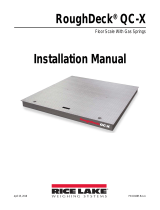
TuffSeal Heavy Capacity Junction Box JB8SP/JB8SPT
8 Visit our website www.RiceLake.com
5.0 Trimming Procedure
Trimming is a process of equalizing the output from multiple individual load cells. If needed, load cell output can be individually
trimmed with potentiometers.
Whenever a substantial amount of trim (more than 7% of normal output), seems necessary to equalize output, check for other
possible problems. The best trim is always the least amount of trim.
The JB8SP and JB8SPT is a signal trimming device with individual and section trimming potentiometers (Figure 4-1 on page 6).
Use the following steps to properly trim the JB8SP and JB8SPT junction box.
If using two junction boxes with an expansion cable between them, make sure to cut the sense trace on the board
that has the homerun cable connected to it (see figure 4-1 on page 5). This ensures sensing out to the furthest
junction box within the system. A sic conductor cable must be used between the two junction boxes to ensure
proper functioning of sense.
1. Determine the number of load cells needed. When section trimming, it is acceptable to use combinations of load cells
other than eight, but the combination must be an even number of cells.
2. Turn all the individual cell and section potentiometers clockwise to give maximum signal output from each section.
Make sure to remove all shunt jumpers of the individual cells that are not being used to disable them and ensure the
section potentiometer is turned fully.
If desired, all the potentiometers can be adjusted 3-5 turns counter-clockwise to allow trim capabilities both positive
and negative.
3. Trim by turning potentiometers counter-clockwise to lower output to match lowest value.
4. Remove all weight from the scale and zero the indicator. Place calibrated test weights over each load cell or section.
The amount of test weights to be used will depend on the scale configuration; for specific recommendations, refer to
the Handbook 44, published by the National Institute of Standards and Technology (NIST).
5. Record the value displayed on the indicator after the test weight is placed in turn over each load cell, or over each
section. Select the load cell or section that has the lowest value as the reference point. This cell or section will not be
trimmed.
6. Place the same test load over each cell or section in turn. Using the corresponding potentiometer, trim each cell or
section down to equal the reference point. As load cell corrections are interactive, check zero after every adjustment to
avoid zero shift.
7. Check cells or sections again and repeat steps six, seven and eight as needed.




















